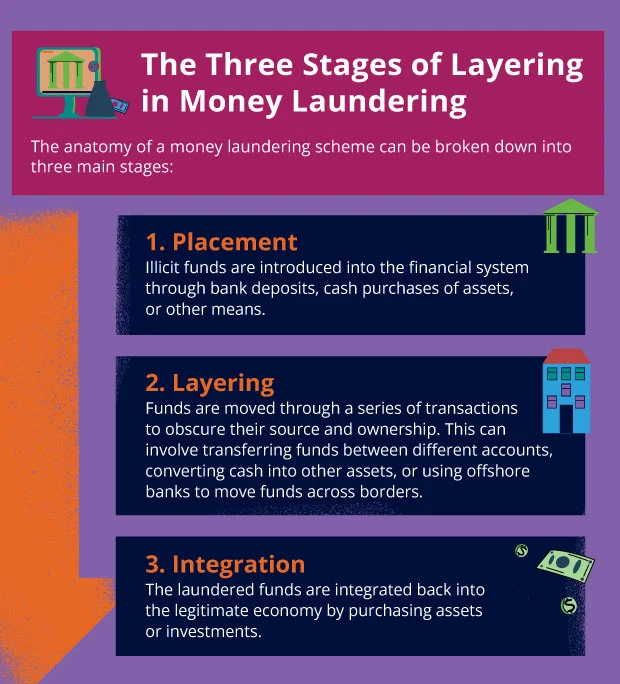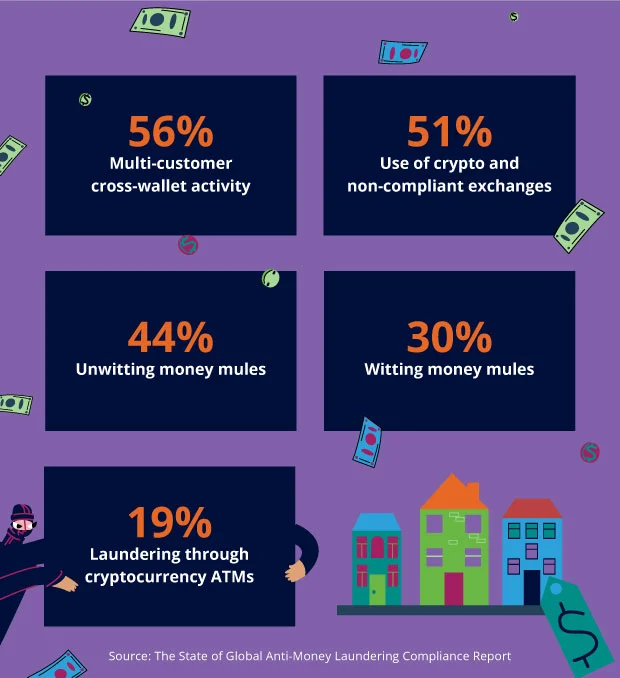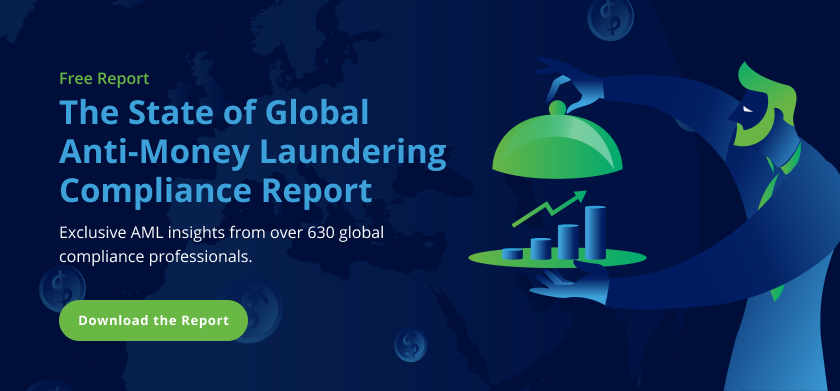
Understanding layering in money laundering is the first step necessary for banks to prevent it. With this knowledge, banks can better protect their customers and the financial system’s integrity. This article explores the three stages of money laundering, emphasizing layering and how it works from a money launderer’s perspective. We will also discuss how banks can prevent layering and detect money laundering activities. This includes transaction monitoring, customer due diligence, and suspicious activity reporting.
What is Layering in Money Laundering?
Layering in money laundering is a process used to disguise the origin, ownership, and destination of illicitly obtained funds. It involves several steps, including moving funds through multiple bank accounts, investing in different financial instruments, and transferring funds between different countries and jurisdictions.
Layering in money laundering creates a complex web of transactions. This arrangement makes it difficult for authorities to follow the money trail and identify the original source of the funds. This is the gradual, calculated, and essential process criminals must execute to “wash” their money before spending it. Similarly, this is a critical element that anti-money laundering (AML) teams must get right. If banks fail to document evidence and report suspicious activity, they’re enabling criminals to get rich at the expense of others. And it all happens right under their noses.
The Three Stages of Layering in Money Laundering
But first, it’s essential to understand the anatomy of a money laundering scheme. This can be broken down into three main stages:
- Placement. Illicit funds are introduced into the financial system through bank deposits, cash purchases of assets, or other means.
- Layering. Funds are moved through a series of transactions to obscure their source and ownership. This can involve transferring funds between different accounts, converting cash into other assets, or moving funds to offshore banks.
- Integration. The laundered funds are integrated back into the legitimate economy by purchasing assets or investments.
Overall, layering in money laundering is an effective method criminals use to conceal the source of illegally acquired funds. This makes it challenging for authorities to track their trail.
How Layering in Money Laundering Works
Here’s an example demonstrating how layering might work in a money laundering scheme:

Step 1: Placement
Marty Money Launderer obtains $1 million in cash from illegal activities, such as drug trafficking. Marty deposits this cash into several different bank accounts in the names of separate shell companies he owns.
Overall, detecting layering in money laundering requires a combination of technology, processes, and people. Banks must remain vigilant and continuously improve their systems to detect and prevent money laundering. By taking proactive steps, banks can help protect their customers, victims of money laundering, and the bank’s hard-earned reputation.
Step 2: Layering
Marty then moves the funds around to obscure their origin and make it difficult for law enforcement to trace them. Marty might use a series of transactions, such as:
- Wire transfers. Using a wire transfer, the money launderer might transfer $100,000 from one shell company’s bank account to another. He might repeat this several times, transferring money between different shell companies in other countries and jurisdictions.
- Purchasing assets. The money launderer might use some funds to purchase high-value assets, such as real estate, vehicles, or artwork. They purchase assets in another shell company’s name, using different payment methods, such as cash, bank transfers, or money orders.
- Investment accounts. The money launderer might use some funds to open investment accounts, such as stocks, bonds, or mutual funds. They might use different brokers and investment firms to make it more difficult to trace the transactions.
Step 3: Integration
Once the funds move through a series of transactions, the money launderer integrates the funds back into the legitimate economy. They do this by:
- Selling assets. The money launderer might sell some of the purchased assets using the laundered funds, such as real estate or vehicles. They might also use legitimate channels like real estate brokers or auto dealerships.
- Liquidating investments. The money launderer might liquidate some of their accounts, converting the assets into cash. They might do this through different brokers and investment firms to avoid detection.
- Re-depositing funds. The money launderer might re-deposit some of the funds back into their own bank account or other shell companies’ bank accounts. The funds are now integrated into the legitimate economy and are difficult to trace back to their illegal origin.
Overall, layering in money laundering is an effective way for criminals to disguise the origin of illicit funds and make it difficult for authorities to trace them. However, financial institutions and regulatory authorities are constantly working to identify and prevent these types of activities through monitoring and analysis of financial transactions.
How Banks Can Detect Layering in Money Laundering
From an AML program perspective, banks can take several steps to detect layering in money laundering. These include:
- Perpetual Know Your Customer (pKYC) procedures. Implement pKYC strategies and technology to continuously risk score their customers and assess the risk associated with their occupation, location of residence, and likely source of their funds. This helps banks quantify the risk and likelihood of the introduction of illicit funds into their banking system.
- Transaction monitoring. Monitor customer transactions closely to detect suspicious activity. They should use software that monitors each customer’s payment patterns and accurately detects anomalies in transactions that indicates suspicious activity. This includes large and frequent transfers or transactions to or from high-risk countries.
- Customer Due Diligence (CDD). Continuously conduct due diligence on their customer base, especially high-risk customers. This involves checking against global risk-related watchlists, adverse media, and politically exposed persons (PEPs) or customers in high-risk industries, to quantify the level of risk they may pose to your bank.
- Risk strategy assessment. Assess your bank’s overall exposure to money laundering and implement appropriate measures to mitigate those risks. This might include regular employee training, periodic risk assessments, and updating internal policies and procedures.
- Suspicious Activity Reports (SARs). Implement a system to report suspicious activity to the relevant authorities. Equally important, this system should have an auditable trail of evidence of suspicious activity and explainable decisions made by investigators. This can help law enforcement agencies investigate suspected money laundering activities, including layering.
Each of these aspects of an AML program are designed to identify and report suspicious activities that may indicate money laundering or other financial crimes.

Here are some common money laundering red flags that AML programs alert for:
- Large or frequent cash transactions. Transactions that are inconsistent with a customer’s known financial profile or business activities may indicate money laundering activity.
- Unusual transactions. Transactions that are unusual for a particular customer, such as transactions outside of their normal business activities or transactions with unknown parties, may be a red flag.
- Suspicious activity patterns. AML programs may identify suspicious patterns of activity, such as multiple transactions just below the reporting threshold, that may indicate an attempt to avoid reporting requirements.
- Politically exposed persons (PEPs). PEPs, such as government officials or their family members, may be at a higher risk for money laundering. Transactions involving PEPs may be subject to greater scrutiny as a result.
- High-risk countries or industries. Transactions involving high-risk countries or industries, such as those with weak AML regulations or high levels of corruption, may be flagged as suspicious.
- Inconsistent customer information. AML programs may flag inconsistencies in customer information, such as mismatched names or addresses, as potential indicators of money laundering.
- Unexplained wealth. A sudden increase in a customer’s wealth, such as an inheritance or business success, may be a red flag for money laundering.
- Complex or layered transactions. Transactions involving complex or layered structures, such as multiple shell companies or offshore accounts, may be flagged as potential money laundering indicators.
By monitoring for these red flags and other suspicious activities, AML programs can help to detect and prevent money laundering and other financial crimes.
Share this article:
Related Posts
0 Comments5 Minutes
Spotlight on Denmark: Fraud and Financial Crime Insights from ‘Den sorte svane’
The recent documentary mini-series "Den sorte svane" has sent shockwaves through Danish…
0 Comments9 Minutes
Enhancing AML Transparency with Smarter Data
Doesn’t it seem like new financial threats crop up in the blink of an eye? That’s why…
0 Comments10 Minutes
Enhancing Anti-money Laundering Systems Architecture
A speaker at a financial crime conference I recently attended summed up the problem with…


